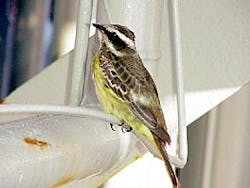Migrants and platforms
Oil and gas platforms on the continental shelf of the northern Gulf of Mexico make up the largest artificial island system in the world, notes a study on bird migration that the US Minerals Management Service released earlier this year.
The network of production facilities, constructed since 1947, falls within a flyway used annually by hundreds of millions of migrating birds in their annual trek across the gulf.
Birds have migrated for ages, but much of the scientific information into migration travelogues has been achieved during the last 50 years.
The MMS financed a 3-year study entitled Interactions between Migrating Birds and Offshore Oil and Gas Platforms in the North Gulf of Mexico. The oil industry cooperated by giving biologists access to 13 platforms. Louisiana State University scientists conducted the study under contract for the MMS.
Field scientists found that platforms provide stopovers for migrating birds in both spring and fall. Fatigued birds use the platforms for rest, shelter, food, and water.
“Platforms may facilitate the evolution of trans-Gulf migration strategies in certain species by providing stepping stones that allow incipient migrants to cross the gulf successfully via a series of shorter flights,” the 325-page report said.
Some birds died during migration. Starvation was the most common cause of death, followed by collision with the platforms.
Study details
BP PLC, Chevron Corp., ConocoPhillips, ExxonMobil Corp., Newfield Exploration Co., and Shell Exploration & Production Co. provided biologists platform living quarters, food, and helicopter transportation.
The study concentrated on major fixed-leg platforms in the area from North Padre Island 975 in the extreme western end of the gulf to Viosca Knoll 786 at the eastern boundary of the MMS Central Planning Area.
A biologist walked each platform on a prescribed route at different times daily to count and identify birds, whose apparent condition also was recorded. Spring and fall migrations were monitored from mid-March 1998 through spring 2000. Biologists staffed one platform for 12 months during 1999-2000.
Researchers expanded the program in 1999 to include insect monitoring, noting that insects were potential prey for foraging bird migrants.
“We discovered that several species of dragonflies and moths are intentional transgulf migrants,” scientists said.
Other conclusions
Prevailing wind influences migratory flight patterns and accounts for subtle route differences, said the scientists, who used Doppler weather radar to determine migration density and patterns.
“Prior to this study, the conventional wisdom had been that spring transgulf migration involves a roughly straight-line, shortest-distance flight from the Yucatan Peninsula to the upper Gulf Coast,” the report said. “Our results support parts of this scenario but also indicate that the situation is considerably more complex.”
Cattle Egrets were a common species found on platforms. White-winged Doves were found to be evolving their migration strategies in concert with their population explosion and major range expansion into the southeastern US, the report said.
Yellow Warblers were considered land migrants until discovered routinely migrating over the gulf. Belted Kingfishers were other platform users that surprised scientists.
“Peregrine Falcons were perhaps the most striking beneficiaries of platforms,” scientists wrote. “This species, which formerly was near extinction [from DDT], underwent a dramatic population recovery that was temporally coincident with the period of fastest expansion of the platform archipelago in the gulf.”
Peregrines often appeared on platforms immediately before weather events that induced large landbird movements, leading researchers to conclude that Peregrines anticipate periods of available migrant landbird prey.
“This adaptive behavior may be a precursor to evolutionary changes,” scientists said. “We predict that Peregrine Falcons will establish a breeding population on platforms in the near future.”
It’s already general knowledge that platforms create their own marine ecology. The MMS study now advances knowledge about platforms and migratory birds. It also provides this OGJ writer with an opportunity to write a positive story about birds and oil.✦

